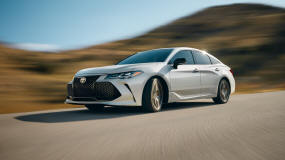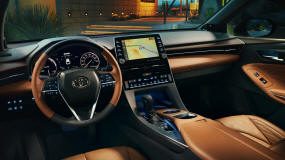 Toyota Avalon Hybrid Electric Car
Toyota Avalon Hybrid Electric Car

 |
 |
 |
View the brochure for the 2020 Avalon here
|
Avalon Hybrid: The Most Fuel Efficient Avalon Ever A new TNGA 2.5-liter four-cylinder Dynamic Force Engine is more fuel efficient, runs cleaner, and is more powerful than previous iterations, and excels at dissipating thermal inefficiencies. Doing it all took the implementation of Toyota's vast catalog of advanced engine technologies: Dual VVT-i with VVT-iE (Variable Valve Timing intelligent system by Electric motor); D-4S (Direct injection 4-stroke gasoline engine Superior version) direct injection and laser-clad valve seats; longer stroke (4.07 inches; bore remains at 3.44 inches) and high compression ratio (14:1); multi-hole direct fuel injectors; a variable cooling system; cooled Exhaust Gas Recirculation (EGR) system; and a full variable oil pump. Instead of oil pressure, its Dual VVT-i with VVT-iE variable valve system employs an electric motor to control variable valve timing, which aids fuel efficiency and promotes cleaner exhaust emissions (this is especially helpful in cold climates). The D-4S direct injection combines higher-pressure direct fuel injection (DI) and lower-pressure port fuel injection (PFI), and applies each method of injection based on specific driving parameters. Furthering fuel efficiency are new multi-hole nozzle direct injectors (six holes per injector).
The Ultimate Happy Marriage The four-cylinder Dynamic Force Engine is married to an all-new Toyota Hybrid System II powertrain that's been engineered to inspire both spirited driving and fuel consciousness. THS II uses two electric motors―MG1 and MG2―to supplement the charging of the hybrid system's Nickel-Metal Hydride (Ni-MH) battery pack, while MG2 assists the engine. New for 2019, the highly compact battery pack now resides under the rear passenger seat (instead of the trunk), as a result of improved TNGA packaging and for the betterment of a lower center of gravity. THS II's new lighter, smaller Power Control Unit (PCU) packages microcontrollers within a power stack structure that's located above the transaxle―all with the goal of lowering mass to better handling composure. Efficiencies on many levels are seen with the implementation of the new PCU. Energy loss in the conversion efficiency of the transaxle and electric motor is reduced by approximately 20 percent, and its cooling system's energy loss is cut by approximately 10 percent. The PCU's DC-DC converter―which converts a direct current from one voltage level to another―is optimized to reduce overall power consumption. Dimensionally, DC-DC converter's output filter is smaller, lighter, and quieter for an improved passenger experience. Auto Glide Control (AGC), yet another of Avalon's fuel-saving technologies, automatically calculates efficient coasting. When driving normally, engine braking will slow the vehicle down when the driver lifts off from the accelerator pedal. However, to avoid aggressive engine braking, AGC limits the loss of vehicle speed through an automatic drive setting that acts more like a neutral gear, allowing the vehicle to coast to the stoplight. A light indicating "AGC" is illuminated on the Multi-Information Display (MID) when AGC is active to alert the driver that less deceleration torque than normal is currently being used. AGC can only be activated when the vehicle is being operated in the ECO drive mode setting. But who said all hybrids are docile? Adding more than a sprinkle of spark to Avalon Hybrid's sporty skillset is the inclusion of a new Sport drive mode and Sequential Shiftmatic technology. The Sport drive mode applies power from the hybrid system for improved acceleration and, as a bonus, all drive modes, including Sport, can each be used while EV mode is activated. With Shiftmatic technology, XSE drivers can "shift" through the Continuously-Variable Transmission's six simulated gears via steering-wheel mounted paddles or the gearshift. Piquing the Adventurous Side Complementing Avalon's daring looks is a thrilling drive personality imbued by an array of available sport-oriented tools―which, together, represent a Toyota first. Adaptive Variable Suspension (AVS), Intake Sound Generator (ISG), grade-specific exhaust baffle tuning, Active Noise Control (ANC), and Engine Sound Enhancement (ESE) fully exemplify Avalon's most adventurous zeal ever. A more comprehensive four-level drive mode selection―which includes Eco, Normal, Sport/Sport+, and Custom―is available on Touring, too. All other grades receive a three-level drive mode selection (Eco, Normal, Sport). Touring's standard Adaptive Variable Suspension (AVS) provides real-time damping control to maximize controllability and sharp handling. The astute setup reduces Avalon's posture fluctuations under hard or sudden directional changes, limits body movements, and yet absorbs nasty road undulations for a comfortable, flat ride. AVS relies on three primary systems to accomplish its mission: shock absorbers at each corner that have solenoid control valves for independent wheel control; advanced front and rear G Sensors to comprehend the vehicle's condition; and, an intelligent central ECU that reacts to the G Sensor's observations by dictating exact damping adjustments to the shock absorbers' solenoids. Levels of AVS' damping force are continuously variable, with a maximum of 650 steps. Changes in solenoid force―which restrict absorber fluid and, thus, damping―happen in an incredible 20 milliseconds. Drivers can adjust Avalon's ride feel with the simple depression of a button―Normal mode prioritizes comfort, while Sport+ emphasizes handling with tauter, highly responsive footing without diminishing Avalon's celebrated ride suppleness. Progressing from Normal to Sport+ also benefits Avalon's liveliness. For example, throttle response becomes quicker, the Electronic Power Steering's (EPS) feel emphasizes feedback, and its engine sound is enhanced through ESE. The new multi-link rear suspension allows for the enhancement of many positive performance attributes, such as a wider rear track, lower center of gravity, and an aggressive stance. Revised trailing arms have been installed at a higher position to place the pivot axis of the tire rearward for better bump absorption. The setup's shock absorbers are tilted forward, too, to realize a suppler ride. Bushings on the trailing arms and arm joints further mask passing road imperfections. Although not equipped with AVS, XLE, Limited, and XSE take full advantage of their innately sporty platform and multi-link rear suspension and, to them, add thicker stabilizer bars and stiffer spring rates for maximum handling dexterity. Spring stiffness, for example, is increased 25 percent when comparing XLE to Limited; stabilizer bar stiffness is up 38 percent and 62 percent, front and rear, respectively, when progressing from XLE to XSE. World Class Acoustics, Inside and Out Avalon's refined acoustic repertoire spans inside and out. Through Sport+, passengers receive a concerto of exciting, natural sounds through a new exhaust system with sport modified baffles, an Intake Sound Generator (ISG), Active Noise Control (ANC), and Engine Sound Enhancement (ESE). ISG amplifies the engine's air inhalation sound to create robust vocalization and, on the exhalation end, the all-new exhaust with baffle tuning ups the sound character at start-up, idle, and acceleration. ANC and ESE work to cancel any unwanted exterior noise while simultaneously enhancing engine sound via the JBL multimedia system's in-cabin speakers. Exceptional engine notes at start-up are also enhanced; a hearty "flare" of sound occurs right before idle upon start-up. At wide-open-throttle acceleration, more engine grunt is heard throughout the rev range. For all its added energetic vocalization, Avalon never ceases to deliver a civilized, library-quiet interior, if desired. Road noise and engine droning have been culled while cruising quietness and engine sound have been improved. Its TNGA platform utilizes additional seals where front fenders meet front doors and where the doors merge at the B-Pillar. More sound absorption material is found in the engine bay, within the carpet pad, under the floor, and in the wheel well liners. The exterior rearview mirrors not only reduce drag, but also wind noise, making for an extremely quite environment for all. Top Toyota Safety Tech Avalon's standard Toyota Safety Sense P (TSS-P) suite of safety systems and technologies represents one step closer to achieving Toyota Motor Corporation's ultimate goal of zero casualties from traffic accidents. TSS-P bundles cutting edge active safety technologies including Pre-Collision System with Pedestrian Detection (PCS w/PD), Full-Speed Range Dynamic Radar Cruise Control (DRCC), Lane Departure Alert with Steering Assist (LDA w/SA); and Automatic High Beams (AHB). Additional standard safety technology includes Blind Spot Monitor (BSM) with Rear Cross Traffic Alert (RCTA) and Back Guide Monitor (BGM). Also available are Panoramic View Monitor with Alert (PVMA) and Intelligent Clearance Sonar (ICS), which now includes a Rear Cross Traffic Braking (RCTB) system. All 2019 Avalons have 10 standard airbags and Toyota's Star Safety System, which includes Enhanced Vehicle Stability Control, Traction Control, Electronic Brake-force Distribution, Brake Assist, Anti-lock Braking System, and Smart Stop Technology. All Avalons also come equipped with a standard backup camera. Assembled with Pride in Kentucky For over two decades, Avalon's sole manufacturing home has been Toyota Motor Manufacturing, Kentucky (TMMK) in Georgetown, KY. All Avalons sold in America and around the globe are assembled in Georgetown by about 8,000 proud American team members. With Avalon as a cornerstone of its U.S. operations, Toyota has been part of the cultural fabric of America for over 60 years. With over $23 billion in direct U.S. investments, including 10 manufacturing facilities, over 1,200 Toyota dealerships, and 136,000 people working across the U.S., Toyota has produced 25 million vehicles in the U.S. over the last 30 years. Preliminary Exterior Dimensions Wheelbase 113.0 in. Overall Length 196.0 in. Overall Width 72.8 in. Overall Height 56.5 in. |
